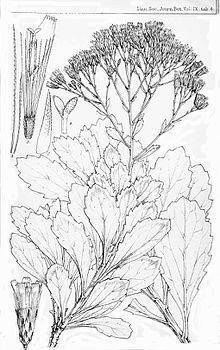Rank Genus | Higher classification Daisy family | |
 | ||
People also search for Axiniphyllum, Damnxanthodium | ||
Catamixis is a genus assigned to the daisy family, with only one known species, Catamixis baccharoides, a low to medium height (¾—1¾ m) shrub. It is native to a very small area of western Nepal and northern India in the Himalayas. It has approximately spoon-shaped, leathery leaves with distanced rounded teeth alternately set along straight, shyly branching stems, and carries many flower heads of about 1 cm, with a few creamy white florets, sometimes with a hint of violet, in corymbs at the end of the branches. Flowers and fruits can be found between March and May. Its vernacular name in Hindi is विषपत्री (vishpatri) or विश्पत्र (vishpatra).
Contents
Description
Catamixis baccharoides is a shrub of ¾—1¾ m high, with straight, shyly branching stems, which are circular in cross-section, initially covered in silky hairs pressed to the surface, but later becoming hairless, carrying alternately set leaves close together, which leave distinct marks after being shed. The leaves are leathery and hairless, 3½—8 cm long and 1½—3½ cm wide, spoon-shaped, the base tapering into the stalk, while the margin is somewhat wavy, with distanced rounded teeth particularly in the upper half. The flower heads are set in corymbs at the end of the branches or in the leaf axils. Each flower head consists of an involucre, 5—6 mm high, with several whorls of lanceolate bracts narrowing into the tip, with papery edges, and contains mostly five, sometimes four or six, hermaphrodite creamy white ligulate florets of 3¾ cm, ending in five shallow, but irregular lobes. Each of the five individual anthers per floret has two spurs at its base, giving them an arrow-shaped foot. Like in all Asteraceae, the pinkish anthers are fused into a tube through which the style grows, while picking up the pollen that is released at the inside of the tube. The shaft of the style only has few hairs at its base. When ripe, the style opens into two branches of about ½ mm with short papillas at the dorsal side. There are no bracts on the common base of the florets. The indehiscent one-seeded fruits (called cypselas) are 2 mm long, covered in velvety hairs, and are adorned by ten longitudinal ribs. The sepals which are changed to barbed 8 mm long hairs called pappus are white in color. The pollen is tricolpate and has some small spines of less than 1 μm.
Common characters with other less related Asteraceae
The flower heads of Catamixis contain florets with ligulate corollas only, a trait shared with the Lactuceae, but also with Fitchia, Hyaloseris, Dinoseris and Glossarion.
Taxonomy
Catamixis baccharoides was described by Thomas Thomson jr. in 1867, who thought it was most closely related to Leucomeris, a genus that is now assigned to the subfamily Wunderlichioideae, tribe Hyalideae. There are no synonyms. It has been difficult to establish the relationships of Catamixis with other asterids, since no substantial analysis of its genetic material has been published sofar. Because it shares the combination of ligulate florets, spurred anthers, and involucres that consist of several whorls of overlapping bracts, the species was initially assigned to the tribe Mutisieae sensu lato, but genetic analysis has since shown that this grouping constitutes a basal evolutionary grade, which has been consequently divided into nine subfamilies. However, further characters of Catamixis are shared with different of these subfamilies or the subdivisions they include, but always elements of the unique character combinations of these subfamilies are lacking in Catamixis. More recently, Catamixis was assumed to be associated with the tribe Pertyeae. Catamixis lacks a deletion of 17 base pairs close to one of the chloroplast NADH dehydrogenase genes, that is a common character for members of the subfamilies Gymnarrhenoideae, Cichorioideae, Corymbioideae and Asteroideae. Catamixis, Pertya, Myripnois and two of the Ainsliaea-species share a deletion of 145 base pairs not found in any lineage except Pertyoideae. A point mutation in the maturase K gene is shared with the genera Ainsliaea and Pertya, which belong to the Pertyoideae. This makes it very likely that Catamixis should be included in the Pertyoideae, but does not fully resolve the position within that subfamily.
Etymology
The name Catamixis is a contraction of the Greek words κατά (kata) and μιξη (mixi), meaning “mixed affinity”, which refers to its combination of characters, that makes it difficult to assign it based on morphology within the Asteraceae.
Distribution
Catamixis is only known from Uttarakhand, India and the Far West of Nepal.
Habitat
Catamixis grows on limestone cliffs and steep, dry and exposed sandy rock faces, at approximately 700 m altitude.
Conservation
Because Catamixis is endangered, it is now being cultivated and propagated in the so-called Germplasm garden at the Forest Research Institute, in Dehradun.
